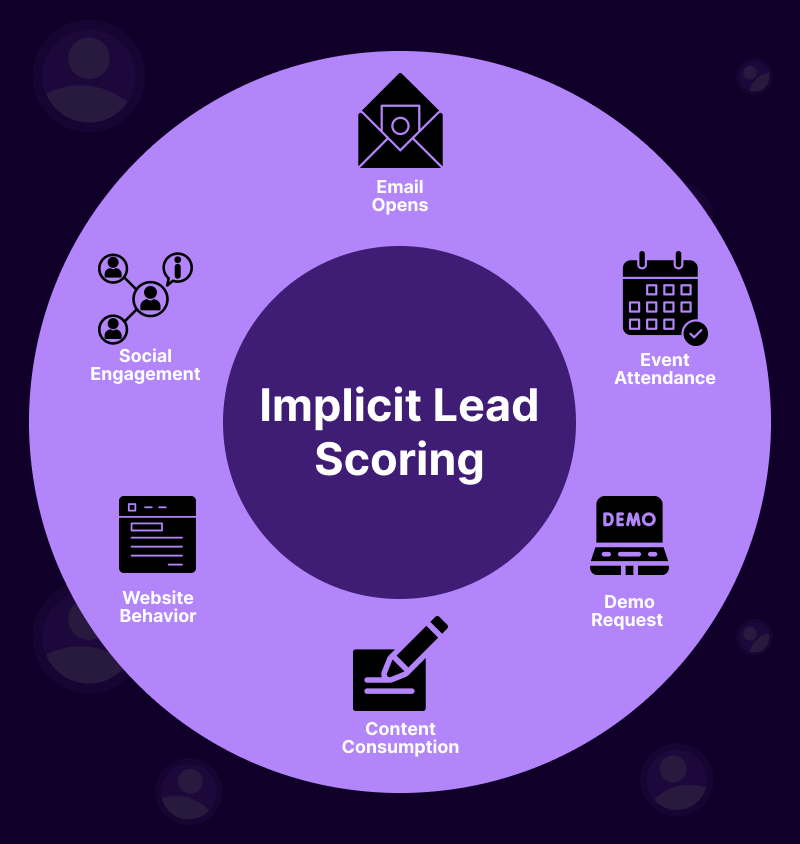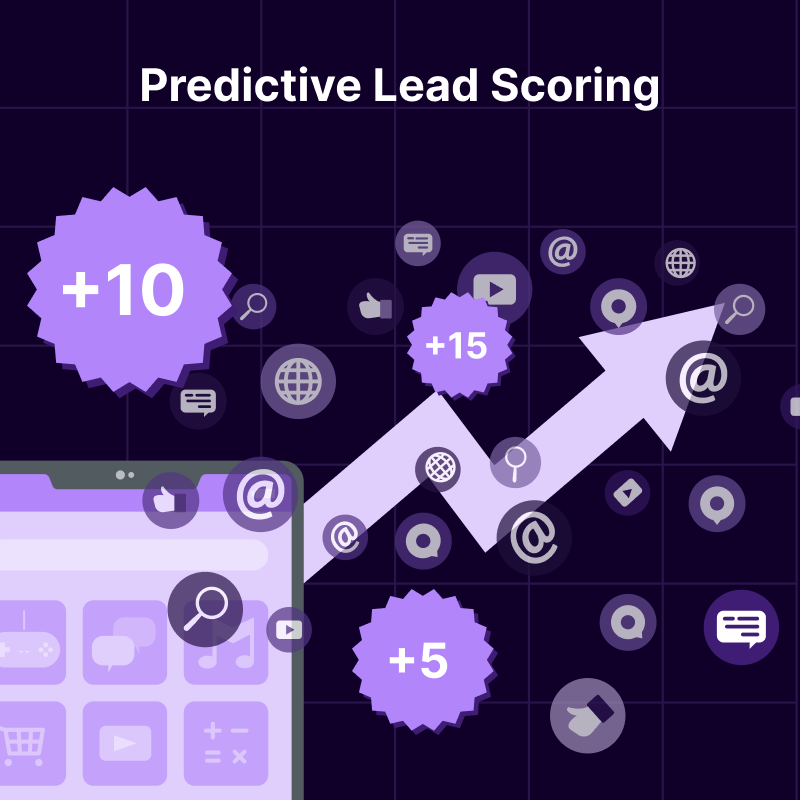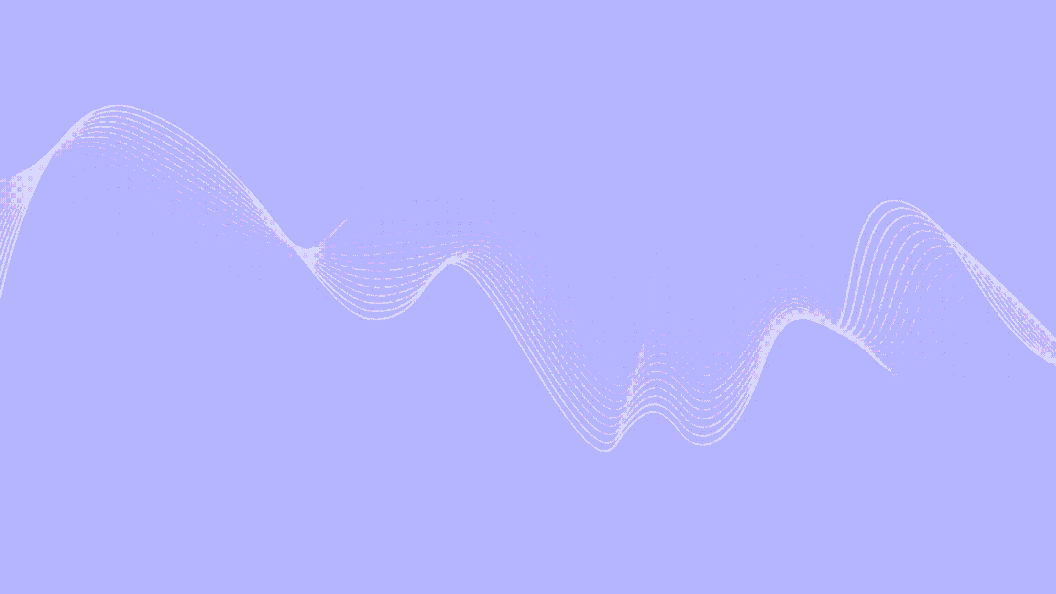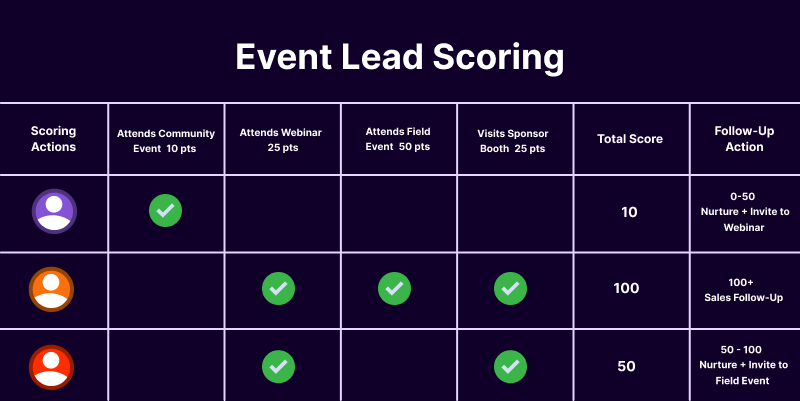The Event Marketer’s Guide to Lead Scoring

Table of Contents
Maximize Your Marketing ROI
Join 10,000 other marketers already getting the best tips on running engaging events that boost pipeline and create raving fans.
Events have officially climbed the ranks and become marketers’ favorite channel to generate new leads.
In fact, according to the 2022 Demand Generation Benchmark Survey, webinars (45%), virtual events/digital experiences (35%), and industry events/trade shows (20%) are among the most effective demand generation tactics.
However, not all event attendees are “leads,” and not all leads are the same. And remember—these “leads” are real people.
Struggling to connect the right event attendees with your sales team? This is where lead scoring comes in handy. 😎
In this post, we’ll break down lead scoring and how event engagement can be included as a helpful scoring source.
Here’s what we’ll cover:
- What is lead scoring?
- Why does your company need lead scoring?
- Lead scoring models
- How to calculate lead scores
- Lead scoring best practices
- Events for lead scoring
What is lead scoring?
Lead scoring is a method of assigning a “score” or points to each lead in your customer relationship management (CRM) platform. Points can be assigned on many attributes and behaviors (which we’ll get to in a bit).
This scoring system is helpful to help indicate how likely a lead is to eventually turn into a customer or advocate. The higher the score, the higher the chances of a lead becoming a customer.
Sifting through data, especially manually, is a time suck. “Lead scoring” was developed as a way to help prioritize folks (leads) in CRMs based on their attributes and behaviors.
Early lead scoring models were simple—think hot, warm, and cold as primary designations. However, lead scoring has evolved to include many more inputs and a lot more nuance in the form of context.

When executed properly, lead scoring can help marketing teams better understand audience, prospect, and customer behaviors and help sales teams focus their efforts on the top 1% of leads that are ready for direct engagement (which we call “sales readiness”).
The score is decided based on multiple factors that you can customize, such as desired buyer persona attributes, website behavior, email open and click-through rate, social media engagement, event engagement, and much more. You simply assign or deduct specific points for each action or attribute. Easy, peasy.
For example, if your product is designed for enterprise marketers at companies with 500+ full-time employees, you would assign a certain number of points for each criterion a lead meets.
Once the lead hits a benchmark, known as the “threshold,” you consider them a marketing-qualified lead (MQL), which is an early indicator of relevance. Then, if the lead continues to engage, they’ll hit another threshold to become a sales-qualified lead (or SQL), which is when the sales team can engage to see if your solution is a good fit.
💡Tip: Your CRM provider likely has a ton of resources on lead scoring! Check out these helpful guides from HubSpot, Marketo, and Salesforce as a starting point.
Why does your company need lead scoring?
Lead scoring is a trusted method to qualify leads and is especially common for B2B companies. An effective lead scoring system takes the guesswork out of the system and surfaces prospects that are sure to convert.
Along with accelerating deal closure, here are three main reasons why many B2B organizations use lead scoring:
1. Align sales and marketing departments 🤝
The absence of an established process that defines a “qualified” lead can cause a lot of conflicts and missed opportunities. The sales team might chase the wrong prospects or miss out on quality leads.
With set and agreed-upon lead scoring criteria, sales and marketing teams can work together to convert high-quality prospects. The two departments can align by setting interaction rules during various lead stages. Sales and marketing can also optimize the lead scoring model over time based on the sales conversations and conversions.
2. Improve sales productivity 📈
According to a Gartner study, 70% of leads won’t convert. Chasing after every lead that enters your funnel isn’t efficient or effective.
A better approach is to follow the famous Pareto principle—roughly 80% of the outcomes come from 20% of actions. Applying this to lead scoring enables salespeople to prioritize the most relevant 20% of leads, driving 80% of the revenue while boosting sales productivity.
3. Build a healthy sales pipeline 💸
Lead scoring isn’t just a way to prioritize sales engagements. It can also be used to build and nurture a “pipeline” of relevant leads—folks that fit your ideal customer profile (ICP) and are warming up to your solution but aren’t quite ready… yet.
You can do this by segmenting leads in your CRM by their score and building different buckets for folks that haven’t hit SQL-level yet but are close. Then, build relevant marketing campaigns around the problems you solve.
The key to making this approach work is to be ultra-segmented and specific with your campaigns. Even though this may be executed at scale, you should think 1:1 versus 1:many.
Executed well, these sustained efforts will build a healthy sales pipeline and stabilize forecasting over time.
According to a Gartner study, 70% of leads won’t convert. Chasing after every lead that enters your funnel isn’t efficient or effective.
What are the lead scoring models?
As any good marketer knows, not every lead you generate is going to convert into a customer—and that’s ok!
Maybe someone is just a fan of your brand and wants to stay in the loop with your content. Or maybe someone is interested in your product, but they don’t have the budget or decision-making power to make a move. Whatever the reason, lead scoring models can be adjusted to help prioritize folks accordingly.
There are two prominent lead scoring models that allow you to rank each prospect on these data points to qualify them. In this section, we will go over the two data categories and how they help in building lead scoring models.
Explicit lead scoring model
The explicit lead scoring model is determined by the prospect’s identity. With this model, no speculation is involved as leads have provided this information while filling out various forms.
The explicit scoring data points resemble buyer persona characteristics as they tend to be demographic and firmographic.
- Job title/role: This helps you assign points based on the lead's seniority level and decision-making or buy-in capability. For example, you could assign CMOs 15 points and mid-level managers 8 points. Alternatively, you could deduct points if the lead has an entry-level position.
- Company size: The company size helps you categorize companies into small, mid, large, and enterprise-level and determine the potential deal size. There’s no “one-size fits all” approach here, so determine the company size buckets that make sense for your solution.
- Company revenue: The company revenue combined with the company size can help you understand if the lead is at a company that needs and can afford your solution.
- Industry: A lead should get the maximum assigned points if they are in your primary target industry. Other industries should get fewer or even negative points.
Location: Similar to the industry, you should assign more points to leads coming from specific areas if that’s important for your sales process.

Implicit lead scoring model
The implicit lead scoring model depends on a lead’s behavioral and engagement data. It tracks prospects’ online behavior, such as website visits, email engagement, event attendance, etc., and gauges their level of interest in your products.
Here are a few examples of implicit lead scoring activities:
- Website visits: You can assign lead scores based on the pages visited and the number of times they visit. Other website behavior that shows purchase intent might include gated content downloads such as whitepapers and e-books. For example, if a prospect visits the pricing page, watches a product demo, or downloads an RFP, you can assign higher points as they show a higher propensity towards purchase.
- Events: Different types of events can indicate different intents. For example, attending a product demo would call for more points than a webinar or community event. Points could (and should!) also be assigned for in-person engagements.
- Email engagement: Signing up for a newsletter is just the first step. Subsequent open rates and click-through rates give marketers a general idea of the lead’s interest. From there, you can dive deeper into email engagement by assigning different points for clicks on blog posts, gated content, product links, etc.
This is just the tip of the iceberg! Depending on your CRM provider, there is so much more you can test to perfect your lead scoring inputs and modeling.

How do you calculate a lead’s score?
The development of automated, rule-based lead scoring models has allowed marketers and salespeople to rely on software applications (aka your CRM) to do all the lead scoring. But it helps to know what exactly goes in that black box so that you know what attributes and models to pick.
Here is how you can calculate a lead’s score:
The manual method
Here are the three steps to calculating the lead score manually:
- Calculate your conversion rate: Begin by calculating the typical lead-to-customer conversion rate, i.e., divide the number of customers by the number of leads and multiply the result by 100. For instance, if 7 leads were converted out of 140, the conversion rate would be 12%. Keep in mind, your conversion rate will likely vary greatly depending on the lead source and type—so segment this data and adjust accordingly.
- Pick attributes of high-quality customers: Next, pick the attributes of your high-quality customers that closely resemble your ideal buyer personas. This will lay the groundwork for the explicit lead scoring model. Among the customers that strongly resemble your buyer personas, pick the common behavioral attributes.
For example, you may notice that after downloading a whitepaper, people often check out your emails every week, register for and attend a webinar, and eventually ask for a demo.
Note that there’s no exact science behind this process, and you may have to experiment to see what works for you and for different types of customers.
- Calculate the score for each attribute: Finally, you want to assign points to the attributes you picked based on their influence on the purchase decision. If we consider identity attributes, certain job roles will get more points than others. It works the same way for behavioral attributes too. Activities like visiting your booth at a trade show or signing up for bottom-of-the-funnel activities (like attending webinars, watching a product demo, and reading product comparisons) will get more points.
As we mentioned, it’s very unlikely that you’ll have to score leads manually. But it’s certainly good to know what goes into the process to help you dissect and optimize your own process over time.
Predictive lead scoring
The problem with manual lead scoring is that you have to manually score each lead in a spreadsheet, which doesn’t scale. A better way to do this is to harness the power of artificial intelligence and machine learning, which are often built into lead-scoring tools (aka your CRM).
Predictive lead scoring models process a lot of data to identify and score attributes influencing customer behavior. Based on the scoring criteria, it presents you with leads that are most likely to convert. And the best part of predictive scoring is that it keeps refining and optimizing the model with the latest data to keep the process updated.

5 lead-scoring best practices
Now that we have covered the basics of lead scoring and what goes into calculating it, let’s look at five best practices to get the most out of your lead scoring process.
1. Introduce a lead scoring threshold
The lead scoring “threshold” is a number that indicates a prospect is primed and ready for sales engagement. When the lead reaches or exceeds this number, marketing should loop in sales for the next steps and outreach.
The threshold you select helps you identify the right opportunity to initiate a conversation, so it’s critical to define the score accurately.
If you have no reference point right now—don’t panic. Start by following up with all “hot” leads equally regardless of their score for a certain duration. You’ll quickly be able to estimate the score which you can introduce as the threshold.
2. Use negative scoring
As we’ve already mentioned, not every visitor that enters your funnel is a lead. For example, a competitor may download your whitepaper to scope out your content—you definitely don’t want to give them even more intel on your sales outreach or nurture campaigns! While assigning points for behaviors, it is also important to consider the full picture.
Marketing and sales should work together to identify a list of characteristics and attributes that indicate that a lead isn’t worth pursuing. By assigning negative scores for such characteristics and attributes, you deduct points from the score so that only sales can focus on converting the strong prospects. Some examples where you could use a negative score are:
- Unsubscribing from an email list
- Not opening your emails for a while
- Not responding to the communication after initial contact
- Visiting irrelevant pages from the sales perspective, like the careers page
- Identity characteristics like job title, geography, or industry that you don’t serve
3. Talk to your customers
Speaking directly with your customers can offer insights that are hard to find from the numbers. Data can help you identify patterns and trends, but you can verify these assumptions and get more context by involving your customers in the process.
First, make sure you’re talking with your customer-facing teams often, including customer success, support, and sales. These folks are goldmines of insight on common pain points, frequently asked questions, and information needed during the sales cycle and beyond.
Listening to sales or customer calls with tools like Gong or Chorus is a great way to do this at scale without taking time away from other teams.
For more in-depth research, schedule 1:1 interviews with customers or prospects to dive deeper into their process when they evaluate new solutions.
4. Track data to identify high-value activities
Analytics lets you dive deeper into behavioral data. Content downloads and event registrations are surface-level activities. Using analytics, you can identify specific content, events, and campaigns that drive the most engagement and conversions.
For example, you can drill into specific content, email campaigns, and virtual events that drive the most engagement, and then assign more points to these activities.
Be sure to look into the analytics of your various providers (email marketing, events, website, etc.) to see how each plays a role in influencing the customer journey.
5. Keep refining your lead scoring system
You won’t land on a perfect lead scoring model on your first try—but don’t get discouraged.
In all honesty, there’s no such thing as a “perfect” lead scoring model. What works for your business will change and evolve over time.
Once you do find a model that works, evaluate your inputs and scoring on a quarterly basis to ensure all components are still relevant and working.
Similarly, if you ever add new tools or tactics to your marketing stack, reevaluate your lead scoring system and make the necessary adjustments.
There’s no such thing as a ‘perfect’ lead scoring model. What works for your business will change and evolve over time.
Events for lead scoring
Alright, that was a lot on lead scoring! If you’ve made it this far, you’re ready to learn more about how events can be used for lead scoring. So, let’s get to it.
As you already know, virtual, hybrid, and in-person events provide marketing teams with tons of information about leads. The key is to use an event platform that integrates with your existing tech stack to automate the data flow. By connecting your event platform with your marketing automation platform and/or CRM, you can add a whole new level of complexity and nuance to your lead scoring.

For example, Goldcast collects granular behavioral information that can be fed into different systems. At a very high level, Goldcast provides an attendee summary, engagement summary, and session summary.
On an individual level, Goldcast collects:
- Sessions attended
- Time spent in sessions
- Resources click data
- Poll responses
- Demo or CTA clicks
- And more!
The best part? You can feed this data into your MAP and/or CRM like HubSpot, Salesforce Pardot, Eloqua, and Marketo to get holistic lead information and improve your lead scoring model.
This level of details and automation simply isn’t possible with platforms like Zoom.
⚡️Tip: Learn more about our marketing and sales tech integrations
Event lead scoring hot tips
Context is everything when using events and event engagement for lead scoring. Just like you’d assign different points for engagement with different types of content, different types of events and engagement require different scores.
For example, a very top-funnel community event should be scored differently than a bottom-funnel product demo.
Here’s a high-level overview of how we score event leads at Goldcast:
- Community events = Top-funnel
- Webinars = Mid-funnel
- Field events = Bottom-funnel
- User/customer events = Retention

Community events, like attending an episode of Event Marketers Live, target a broad audience. We use these events to educate our audience and share thought leadership within the industry. The main goal of these events is to reach a relevant audience and introduce them to Goldcast. These attendees get the lowest score.
Webinars at Goldcast broadly target the middle of the funnel. They are designed to educate and inspire our audience on event strategy and best practices. As such, we score these attendees with a moderate amount of points.
Field events at Goldcast are very targeted and only offered to select prospects. We want to really wow these folks with a highly personalized and curated event. We assign these leads maximum points for attending these types of events.
Individual event behaviors like questions asked and poll responses can also be scored individually.
Take a look at your event strategy, how each type of event aligns with the funnel, how important individual behaviors are, and score those actions accordingly.
Here’s what this might look like:

Events + Lead Scoring = More Pipeline
Phew! That was quite a read. We hope the article has helped you understand the basics of lead scoring and how events can be used to score leads. Like any sales or marketing activity, establishing a solid lead scoring process requires research, experimentation, and refinement. But the rewards are certainly worth the effort!

Transform Your Video Marketing with AI
Stay In Touch
Platform
Resources
© 2025 Copyright Goldcast, Inc. All rights reserved.





 Upcoming Events
Upcoming Events Event Series
Event Series On-Demand Events
On-Demand Events

